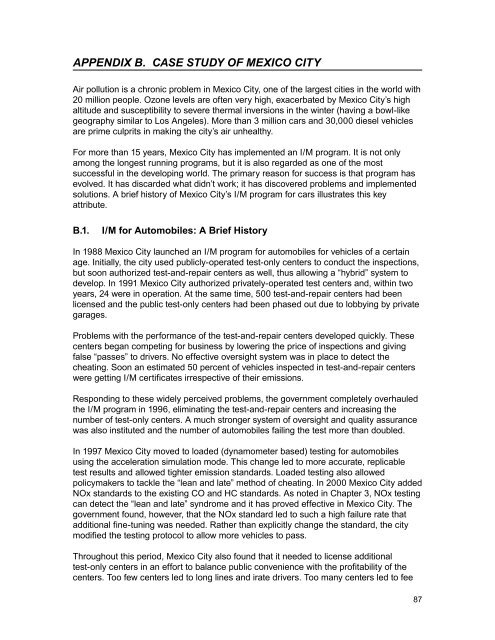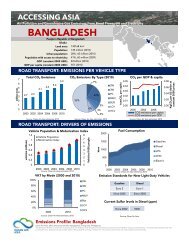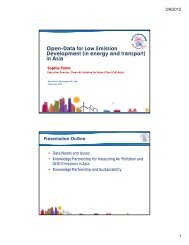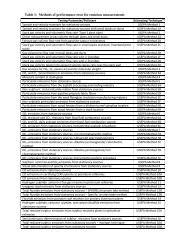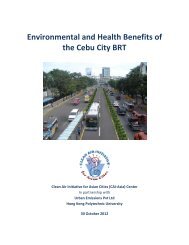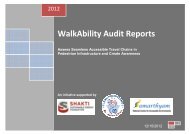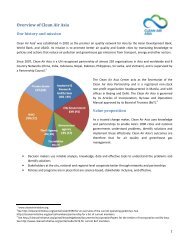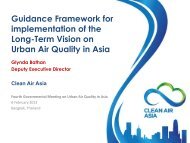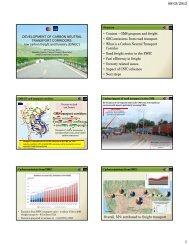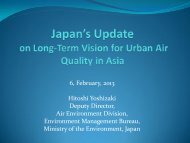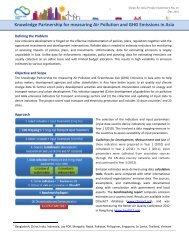International Experience and Best Practices - Clean Air Initiative
International Experience and Best Practices - Clean Air Initiative
International Experience and Best Practices - Clean Air Initiative
You also want an ePaper? Increase the reach of your titles
YUMPU automatically turns print PDFs into web optimized ePapers that Google loves.
APPENDIX B. CASE STUDY OF MEXICO CITY<br />
<strong>Air</strong> pollution is a chronic problem in Mexico City, one of the largest cities in the world with<br />
20 million people. Ozone levels are often very high, exacerbated by Mexico City’s high<br />
altitude <strong>and</strong> susceptibility to severe thermal inversions in the winter (having a bowl-like<br />
geography similar to Los Angeles). More than 3 million cars <strong>and</strong> 30,000 diesel vehicles<br />
are prime culprits in making the city’s air unhealthy.<br />
For more than 15 years, Mexico City has implemented an I/M program. It is not only<br />
among the longest running programs, but it is also regarded as one of the most<br />
successful in the developing world. The primary reason for success is that program has<br />
evolved. It has discarded what didn’t work; it has discovered problems <strong>and</strong> implemented<br />
solutions. A brief history of Mexico City’s I/M program for cars illustrates this key<br />
attribute.<br />
B.1. I/M for Automobiles: A Brief History<br />
In 1988 Mexico City launched an I/M program for automobiles for vehicles of a certain<br />
age. Initially, the city used publicly-operated test-only centers to conduct the inspections,<br />
but soon authorized test-<strong>and</strong>-repair centers as well, thus allowing a “hybrid” system to<br />
develop. In 1991 Mexico City authorized privately-operated test centers <strong>and</strong>, within two<br />
years, 24 were in operation. At the same time, 500 test-<strong>and</strong>-repair centers had been<br />
licensed <strong>and</strong> the public test-only centers had been phased out due to lobbying by private<br />
garages.<br />
Problems with the performance of the test-<strong>and</strong>-repair centers developed quickly. These<br />
centers began competing for business by lowering the price of inspections <strong>and</strong> giving<br />
false “passes” to drivers. No effective oversight system was in place to detect the<br />
cheating. Soon an estimated 50 percent of vehicles inspected in test-<strong>and</strong>-repair centers<br />
were getting I/M certificates irrespective of their emissions.<br />
Responding to these widely perceived problems, the government completely overhauled<br />
the I/M program in 1996, eliminating the test-<strong>and</strong>-repair centers <strong>and</strong> increasing the<br />
number of test-only centers. A much stronger system of oversight <strong>and</strong> quality assurance<br />
was also instituted <strong>and</strong> the number of automobiles failing the test more than doubled.<br />
In 1997 Mexico City moved to loaded (dynamometer based) testing for automobiles<br />
using the acceleration simulation mode. This change led to more accurate, replicable<br />
test results <strong>and</strong> allowed tighter emission st<strong>and</strong>ards. Loaded testing also allowed<br />
policymakers to tackle the “lean <strong>and</strong> late” method of cheating. In 2000 Mexico City added<br />
NOx st<strong>and</strong>ards to the existing CO <strong>and</strong> HC st<strong>and</strong>ards. As noted in Chapter 3, NOx testing<br />
can detect the “lean <strong>and</strong> late” syndrome <strong>and</strong> it has proved effective in Mexico City. The<br />
government found, however, that the NOx st<strong>and</strong>ard led to such a high failure rate that<br />
additional fine-tuning was needed. Rather than explicitly change the st<strong>and</strong>ard, the city<br />
modified the testing protocol to allow more vehicles to pass.<br />
Throughout this period, Mexico City also found that it needed to license additional<br />
test-only centers in an effort to balance public convenience with the profitability of the<br />
centers. Too few centers led to long lines <strong>and</strong> irate drivers. Too many centers led to fee<br />
87


